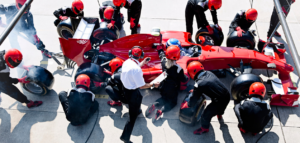“To finish first, you need to first finish” - Welcome to the world of Formula 1
Nothing fascinates humans quite like a fast car engineered to go from 0 to 100 kmph in ~2.5 seconds. The same cars are also capable of going from 300 kmph down to 100 kmph within the same timeframe. Driving such a car is not only a matter of immense honour but also a matter of immense danger.
Formula 1 is the pinnacle of single-seater competitive racing. It is a championship series hosted every year, with races taking place across the world. From the USA to Asia, from Europe to Australia, the F1 carnival travels across the world every year, attracting more than 1.5 million fans to the circuit.
With the dawn of the Turbo hybrid era, F1 engines are, without a doubt, the most advanced and cutting-edge engines in the world. These engines have ~1400 horsepowers, equivalent to the horsepower of 17 Maruti Suzuki Swift or 2 times that of Tesla’s high-end S series. Even at the paltry speeds (in F1 terms) of 150 kmph, an F1 driver experiences more than 1.5 times the forces of gravity.

While I can talk about specs all day, the reason F1 is so exciting is because of the risks these drivers are willing to take. With all cars more or less performing at similar levels, it is up to the drivers to take on the high-risk manoeuvres to move ahead of their opponents. Imagine trying to overtake another car at 300 kmph, with just 200 mts or so of the turn provided to apply the brakes.
This edge-of-the-seat thrill is what makes F1 one of the best sport to watch. Drivers regularly put their lives on the line by braking late into the corners. This strategy gives them a speed advantage, helping them overtake their opponent. Even a small mistake from either them or their opponent could mean curtains to their life. Let Daniel Bruhl, who plays Niki Lauda, four-time F1 world champion and one of the greatest driver in F1 history, emphasize how dangerous Formula 1 is:
“I accept every time I get in my car there’s 20% chance I could die,” declares actor Daniel Bruhl, who plays Niki Lauda in the film. “What kind of person does a job like this?” he asks. “Each year two of us die.”
Accidents and deaths are fairly common in Formula 1. Since the 1950s, 52 F1 drivers have had fatal car crashes on the circuit. The weekend of 1994 in the San Marino Grand Prix was particularly deadly, with Roland Ratzenberger and Ayrton Senna, a three-time F1 world champion, losing their lives.
Between 1950-1980, 29 drivers lost their lives in high-speed crashes. While the safety regulations for F1 drivers have improved drastically, it doesn’t take a lot for things to go wrong, even now.

In the 2019 Belgian Grand Prix, F2 driver Anthoine Hubert took a nasty shunt and lost his life. In the 2020 Bahrain Grand Prix, Romain Grosjean was bumped by Daniil Kvyat in what seemed like a racing incident. Romain lost control of his car and hit the barriers at 300 kmph. That is equivalent to being hit by 50 times the force of gravity.
His car immediately broke into two pieces and caught fire. The inferno was ghastly and was caused due to the fuel spilling all over the car and the driver. Romain got out of it within 30 seconds but still ended up enduring lasting second-degree burns to his hands. This was even after the fact that F1 drivers wear fireproof suits and gloves.
This is exactly why the title of this article quotes seven-time F1 world champion and potentially the greatest driver in the history of F1, Michael Schumacher: “To finish first, you need to first finish.”
Formula 1 is a spectacle. It is a privilege bestowed upon us to watch cutting-edge technology amalgamated into the greatest piece of engineering by some of the smartest minds in the world. It has thrills, drama, intense competition and superstars, everything top-level sport needs. Thanks to “Drive to Survive”, it now has a strong base of millennials following the sport.
At Sportskhabri, we are writing a series of articles to help you get started with Formula 1, ahead of the kick-off of the 2021 season on the 28th of March. Look out for our articles and do share your thoughts or any specific questions you would like us to answer in the comments section.
Written By
Chirag Bhattad

